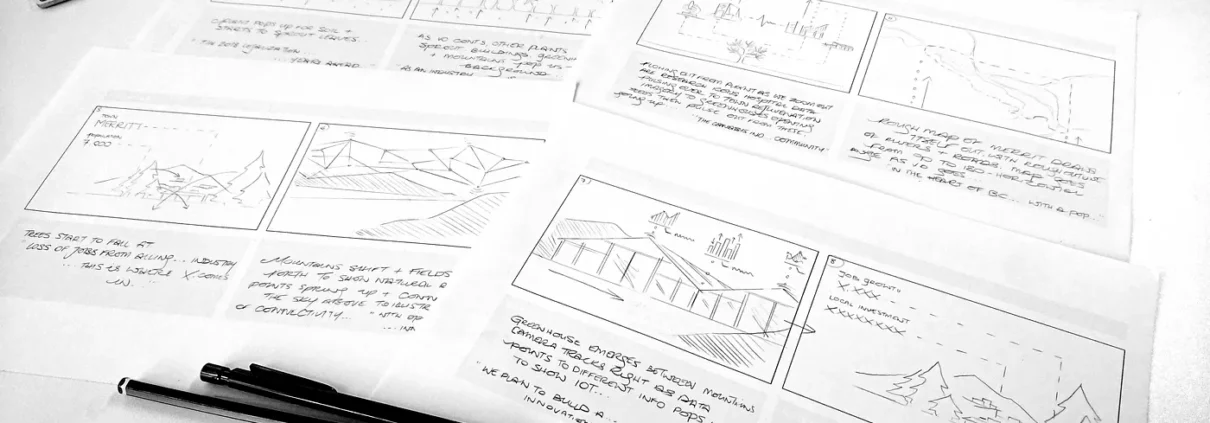Explainer video script? No problem
I find some of my best work comes from tight situations. This has proven true throughout my various jobs around London and definitely in my capacity as an Art Director back in Ireland. There is a mad rush about the sudden, unforeseen situations that spark the fight or flight flame in all of us and in the creative field, sometimes you need to step up to be the MacGyver that’s needed and with only your wiles (and maybe a scrap of paper and a paperclip) know your end goal and drive the work to where it needs to go.
This article is basically the summary of a particularly effective business development conversation that we had in Elemental Concept over a year ago. And as all the best stories come from tight situations, we all know this started with the most ideal working conditions, right? Not really…
The challenge
A client walks in, saying that they need to get a video out within the week to be able to pitch in front of an incredibly influential group of investors, all the stars have aligned, their time is now, etc. And all the only other small thing they need (I can hear the designers shaking their heads in the back as I type…) is a simple, animated explainer video.
There was no script. No existing messaging. And the client had only half an hour of his time to give before he had to leave…
“There is no point in having sharp images when you’ve fuzzy ideas.”
Jean-Luc Godard
Panic Stations?
Now instinct would be to panic, but what a challenge to step up to here. What better scenario to breathe, take the opportunity to roll the sleeves up and face the situation head on and drill our client until we got what we needed.
My art director roots in film and TV was to come back into play, in tandem with the UX challenge of shaping a message that would engage the user’s motivations in the right way to get them to engage. I was extremely lucky in having a fantastic motion graphics designer in Leigh Williamson so I was confident in his ability to knock out an animation within the crazy timeframe. But we needed a script, we needed a story.
And so this simple script generation template was born. From that half an hour of frenzied typing and questioning, came this lovely simple resource that’s proved itself useful over and over and over again. At the end of the day, we love a structure and when it comes to a story we can digest, there’s no more straightforward way than this.
No experience in script-writing needed
You need no experience in writing or scripting to do this – Just an understanding of your client’s business and the right questions to ask to fill out our 4 paragraph script template which will help you translate your client’s business model summary and elevator pitch into a succinct and compelling story that drives engagement. Let’s get into it…

The 4 Paragraph Script Generation Template
The 4 Paragraph Script Generation Template
Paragraph One: Frame the problem
Provide a brief intro to the issue we wish to solve, (whether general or using a particular use-case), all the parties it negatively affects, the impact on X, Y and Z and why it needs to be solved, etc.
Paragraph Two: Frame the solution
Name our solution and how it works to directly answer our problem. What inspired it and what its mission/desired impact is, etc.
Paragraph Three: Sell them on the benefits
List all the benefits of using this solution, particularly referencing issues named in paragraph one or in the established use-case, etc.
Paragraph Four: Summarise the story and main takeaways
Recollect the original issue, how this solution works using X, Y and Z to ensure not only are your problems solved but you’ve provided a good experience, happy customers and other benefits, like scalable offering, modern tech, etc.
Bear in mind, the last statement should always focus back to the name of company, logo and product, using a snappy tagline or a sentence summing up why it’s the future, why it’s the default choice, etc.
End with a bang.
Next steps
So, you have your fact finding template, successfully distilled the necessary content from the client – What next? We need to start polishing creating a narrative and polishing these bare bones into a fully fleshed script.
Things to be mindful of:
- Make sure you’re telling a story
This template enables you to establish the bare bones that will shape your story, but it’s up to you to ensure there’s a flow and a strong narrative sense to all the information. Get your first draft shaped and send out to your client to ensure message is captured correctly and iterate from there. - Keep your brand voice in mind
The content in your video expresses the ‘voice’ of your company or brand, so it’s good to be mindful of the type of voice you want to have. It works in concert with your whole visual and digital presence, your social media connections, your product interface, and your event and experience branding. - Get to the point quickly
Remember your user. UX 101: What is the message you want the user to get out of this? Get this out there as soon as possible and don’t allow the core message to get lost in details. - Read the script aloud
This is not a document, this is a living script that needs to be read, that needs to flow off the tongue and resonate in an auditory way, as well as inspire visuals to go alongside it. Reading your words aloud is essential to finding stumbling blocks in the text, seeing where you need to cut sentences that are too long and editing from there. - Keep it short
Wistia’s research tells us that on average, they would track a 5% difference in the length a user would watch. For example, a viewer would watch 42 seconds of a 60 second video, 78 seconds of a 120 second video. So, in conclusion, the longer your video is, the more content your viewers are going to miss out on. Make as many revisions and edits as possible to keep it clear, concise and snappy.
The happy end to the tale was that we successfully delivered to our deadline and in the process, created an asset that has continued to save time, provide great value and solid structure to how we shape and define stories for our clients.
“Once you crack the script, everything else follows.”
Ridley Scott
Nailing the explainer script has the benefit of laying the foundations for website and pitch-deck content, as well as really defining the voice and identity of an emerging brand or product.
Lack of experience is irrelevant – That’s the beauty of the template. It does your thinking for you, frames the key questions to put to the client and lays the groundwork for success. Like any mountain that seems impossible to climb, it’s not a question of being unsurmountable.
It’s simply a question of knowing where to start.



